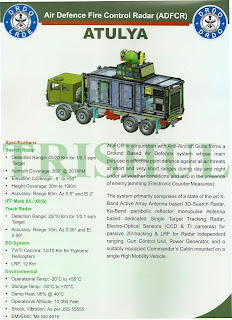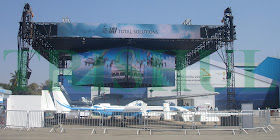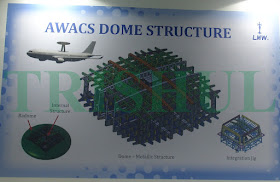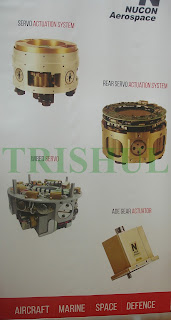This year’s expo showcased two new-generation
weapon systems that are expected to enter service by 2020 at best, these being
the QR-SAM for the Indian Army’s Corps of Air-Defence Artillery (CADA), and the
MPATGM for the Indian Army’s infantry battalions.
The QR-SAM will use a surface-launched version
of the Astra-1 BVRAAM and it will use a Ku-band seeker developed by the DRDO’s
Research Centre Imarat (RCI) and produced by VEM Technologies. The target
detection and engagement radars are being developed by the DRDO’s LRDE
laboratory, while overall systems integration is the responsibility of Bharat
Electronics Ltd.
LRDE is also developing a new-generation
target acquisition/fire-control system, called ATULYA, for the L-70 and ZU-23
anti-aircraft artillery guns used by CADA.
Meanwhile, series-production of the Barak-8 family of LR-SAM/MR-SAM is picking up steam. The Barak-8’s critical design review was
completed by early May 2008 and its DRDL-developed two-stage pulsed rocket
motor was successfully test-fired earlier the same year. The first six sets of
these rocket motors were shipped to IAI by the DRDL in July 2008 for further
test and integration activities. Series production by BDL began in 2013. From
the Indian side, the principal R & D players for both variants of the
Barak-8 are the DRDL, Hyderabad-based Research Centre Imarat (RCI) and Advanced
Systems Laboratory (ASL), the Bengaluru-based Electronics R & D
Establishment (LRDE) and Larsen & Toubro. Israeli companies participating
in the joint venture are the MLM and ELTA Systems business divisions of IAI.
While IAI/MLM was responsible for developing the guided-missiles along with the
DRDL, RCI and ASL, IAI/ELTA has co-developed along with the LRDE and Bharat
Electronics Ltd (BEL) the command-and-control system and related fire-control
system (for both variants of the Barak-8).
It may be recalled that India and Israel inked the Barak-8 surface-to-air missile’s (SAM) joint five-year R & D contract--valued at US$556 million--on January 27, 2006, following 17 months of exhaustive negotiations. For extended ground-based long-range air defence India’s Cabinet Committee on National Security had on July 12, 2007 approved a $2.47 billion project to co-develop the long-range-SAM variant. Subsequently, on February 27, 2009 India signed a $1.4 billion R & D contract with the MoD-owned Bharat Dynamics Ltd (BDL) for the Barak-8 MR-SAM for the IAF, and this was followed in April the same year by a $1.1 billion contract for procuring the Barak-8’s naval LR-SAM variant. The IAF has already committed itself to procuring an initial batch of nine Barak-8 MR-SAM squadrons. The procurement contract will be inked later this year, with deliveries commencing within 72 months. The vertical launch cell modules for the Barak-8 have since been developed by Mumbai-based Larsen & Toubro Ltd, with an eight-cell module weighing 1,700kg. For the IAF’s ground-based MR-SAM variant, command-and-control plus fire-control will be provided by a containerised system weighing only 1,300kg.
Another indigenous field
artillery-specific solution developed by the DRDO’s LRDE lab is the L-band
‘Swathi’ weapon locating radar (WLR) at a cost of US$49 million.
Under development
since April 2002, this WLR was ready for series-production by Bharat
Electronics Ltd by late 2011 and deliveries of 30 units are presently underway.
The IA had in September 2004 awarded a
$300 million contract to Bharat Electronics Ltd to develop the Shakti ACCCS.
Production deliveries commenced in 2008 and the system was commissioned on June
12, 2009. The ACCCS is a network of military grade tactical computers that
automates and facilitates decision support for all the operational aspects of
artillery functions from the Corps down to a Battery-level in a networked
environment. It was jointly developed by the DRDO’s Centre for Artificial
Intelligence & Robotics (CAIR), Armament Research & Development
Establishment (ARDE) and IA HQ’s Directorate General of Information Systems
(DGIS). ACCCS is the artillery component of the IA’s TAC-C3I grid. Shakti’s
three main electronic devices are the enhanced tactical computer, gun display
unit and the hand-held computer. With these, five critical functions are performed,
including ‘Technical Fire Control’ for trajectory computations, and ‘Tactical
Fire Control’ involving the processing of fire-assault requests and ammunition
usage/supply management. It also ensures ‘Deployment Management’ for field
howitzers and forward observation/fire direction posts for defensive and
offensive operations, ‘Operational Logistics’ for assisting in the timely
provisioning of ammunition and logistics support, and ‘Fire Planning’ to
facilitate the production of interleaved fire-assault plans, tasking tables and
automatic generation of gun engagement programmes.
Most of the bureaucratic decks have already
been cleared for a landmark, long-awaited
agreement between India and the US that calls for the joint development
and production of the Indian Army’s next-generation manportable ATGM (MPATGM)
that will use thermobaric-HEDP and tandem shaped-charge warheads optimised for
high-altitude warfare and anti-armour engagements. This ATGM has been the
subject of much speculation, like it being the SAMHO, or a derivative of Raytheon’s
third-generation FGM-148 Javelin fire-and-forget ATGM.
In reality, the MPATGM has been under
development since 2009 by the DRDL, with VEM Technologies being responsible for
product engineering development. Raytheon has already
secured US approval for 97% transfer-of-technology (ToT) for licence-producing
the missile’s cooled mid-wave imaging infra-red (MWIIR) seeker, and will
withhold only the target acquisition algorithms. Both Bharat Dynamics Ltd (BDL)
and Ordnance Factory Board (OFB) will be responsible for the joint development
of thermobaric-HEDP and HE/FRAG penetration-cum-blast warheads, while the
re-usuable launchers and missiles will be built by both VEM Technologies and BDL. A cooled MWIIR
sensor can passively lock-on to targets at up to 50% farther range than an
uncooled sensor, thus allowing the firing crew greater and safer standoff
distance, and less likely to be exposed to counter-fire. An uncooled long-wave
infra-red (LWIR) sensor on the other hand brings increased repairs, decreased
operational availability, and dangerous vulnerabilities, while a cooled IIR
sensor saves lives, lessens fratricide, minimises collateral damage, lowers
risk, and protects its firing platforms/crew. Present plans call for equipping the Indian Army’s existing 356 infantry
battalions of the 1.13 million-strong Indian Army and the projected 30 infantry battalions
to be raised in the 13th five-year defence plan (2018-2022) with
some 6,000 MPATGM launchers and up to 26,000 missile-rounds (including war
wastage reserves).
A similar practice had earlier led to
the development of the 4km-range Nag ATGM and its air-launched HELINA variant.
Back in 2005, the IA had ordered 443 Nag missiles
and 13 NAMICA tracked carrier/launch vehicles, and is expected to order another 7,000 Nag missiles and around 200 NAMICAs.
The 4km-range Nag uses a RCI-developed uncooled LWIR sensor containing
an IR-CCD supplied by France-based ULIS/Sofradir. For the 6km-range HELINA, the
DRDO has developed a two-way RF command-video data-link. The
missile-to-helicopter down-link used to pass the LWIR seeker video works in the
S band and the helicopter-to-missile up-link to pass steering commands works in
the C band. In addition, a DS-SS modulation scheme is used for the command
up-link while a conventional FM technique is used for video down-link,
respectively.
Despite the fact that the LCA AF Mk.2’s (the term Tejas Mk.2 has now been discarded) final
design has yet to be frozen, ADA nevertheless went ahead and released conceptual
illustrations of this MRCA that can only serve to create further ill-informed confusion
and false assumptions.
The two slides below explain
the performance parameters of the Su-30MKI’s existing powerplant (AL-31FP)
and the one (AL-41F-1S) that will power these H-MRCAs after the expiry of the
TTSLs of the existing turbofans.
Instead of trying to re-invent the wheel and cling on to legacy designs, HAL would be well-advised to join forces with KAMOV OKB of Russia to co-develop the next-generation Ka-92 MRH. If this were to be done, it will offer India the way to squeeze out of the earlier ill-fated/ill-advised commitment to procure the Ka-226T.
The slide above is the first definitive illustration of the SAAW directed-energy weapon that is now being co-developed by RAFAEL of Israel and the DRDL.
Seen above and below are slides showing the future developmental objectives of the DRDO for both target acquisition optronic/RF seekers, and for their on-board navigation systems.
This will be the RVV-AE-ZRK LRAAM to go on board the FGFA. It will also be qualified on the Super Su-30MKI.
Shown below are the next-generation AAMs now being developed in China.





























































































































